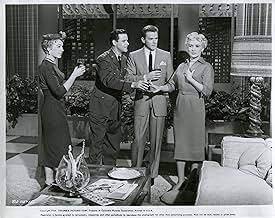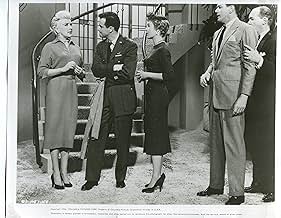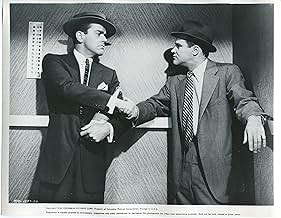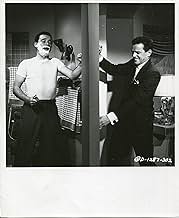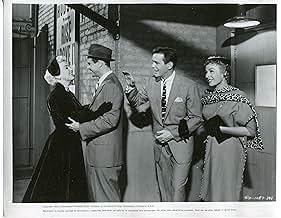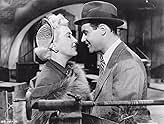अपनी भाषा में प्लॉट जोड़ेंA widowed singer marries her deceased husband's songwriting partner which leads to trouble when her former husband turns up very much alive.A widowed singer marries her deceased husband's songwriting partner which leads to trouble when her former husband turns up very much alive.A widowed singer marries her deceased husband's songwriting partner which leads to trouble when her former husband turns up very much alive.
- निर्देशक
- लेखक
- स्टार
David Ahdar
- Male Harem Dancer
- (बिना क्रेडिट के)
Leon Alton
- Stage Manager
- (बिना क्रेडिट के)
Tom Anthony
- Bit Role
- (बिना क्रेडिट के)
Robert Bice
- Sgt. Charlie O'Hallihan
- (बिना क्रेडिट के)
Bill Boes
- Male Harem Dancer
- (बिना क्रेडिट के)
Eugene Borden
- Costume Designer
- (बिना क्रेडिट के)
Johnny Brazil
- Male Harem Dancer
- (बिना क्रेडिट के)
Eddie Brown
- Male Harem Dancer
- (बिना क्रेडिट के)
George Bruggeman
- Male Harem Dancer
- (बिना क्रेडिट के)
Aileen Carlyle
- Mother
- (बिना क्रेडिट के)
Beulah Christian
- Wardrobe Woman
- (बिना क्रेडिट के)
Gene Dailey
- Male Harem Dancer
- (बिना क्रेडिट के)
John David
- Male Harem Dancer
- (बिना क्रेडिट के)
फ़ीचर्ड समीक्षाएं
Much has been said to deride this film, it's stars, it's musical format and general premise but I enjoy it
from start to finish. Another musical (from Britain) also released in the mid-fifties ; "Let's Be Happy"
was equally dismissed by critics and public and both films are remembered by devotees only. It's a pity
that both of these musicals brought to a cruel halt the film careers of Betty Grable and Vera-Ellen
respectively ; two of filmdom's brightest and loveliest ladies still in their prime.
The above mentioned musicals are two of my favourites and how overjoyed I am that they have both been preserved on DVD in wide-screen and glorious colour. I'm one very satisfied customer.
The above mentioned musicals are two of my favourites and how overjoyed I am that they have both been preserved on DVD in wide-screen and glorious colour. I'm one very satisfied customer.
Musical version of 1940's "Too Many Husbands", via W. Somerset Maugham's play "Home and Beauty" (which the author said he wrote as a lark), has widowed--and remarried--Broadway star in a marital quandary: her first husband's death overseas was misreported by the US Air Force (he was actually marooned on an island), and now she has two husbands...and both marriages legal! Betty Grable toys with the possibilities--she even fantasizes a musical number with dozens of suitors housed in cages, climaxing with she and her two husbands under the sheets smoking a hookah! But, this being 1955, we instead have Betty ordering both her husbands out of her boudoir come bedtime. The plot predicament, not surprisingly, doesn't come to much, but in the interim we have some bright moments, not the least of which is Grable's Marilyn Monroe-like delivery in the final number, "How Come You Do Me Like You Do" (which sounds a lot like MM's "Lazy" with a design resembling her "Heat Wave"). Director H. C. Potter opens the picture with a berserk pantomime number danced to "Someone To Watch Over Me" (in harlequin costumes!), but he gets good performances from both Grable and Jack Lemmon (who also sings a little and dances a bit). As the second couple, Marge and Gower Champion dance nicely together but don't have much pizzazz, much like the rest of "Three For the Show". A pleasant marquee-filler but hardly a headliner. **1/2 from ****
..and with Marge and Gower Champion and Jack Lemmon...it is lots of fun. Fun is what Betty Grable was about...and this film is at its best during those sequences aimed at amusing. ...These days people do not understand Betty Grable very well. In her day she was everyman's and every womans ideal. Indeed no woman has broken Betty's box office record (eleven years in the top ten). And, in the forties and early fifties, women still dominated the box office to an amazing degree--Mom chose the films the family was going out to see. Though it was a bit early to be obvious, Betty in many ways represented a manifestation of what we would now call a liberated woman. She was nearly always working (in revealing clothing!), and she was self supporting. In real life she was a very successful working mother--and particularly during WWII she was an inspiration to women manning the homefront as much as an inspiration to the armed forces fighting overseas. She was pretty, talented, popular, and the highest salaried woman in the United States. Now she is remembered primarily as a 'pin up'--which she also was, but the title tends to diminish the many other factors that created her popularity. One thing is certain, in "Three for the Show" or any other of her starring films--she will entertain you royally within the limitations of the material she was given.
It was only a matter of time before a movie musical would be made with an "Enoch Arden" plot. This 1955 Columbia musical was it. Although the film writing credits list a W. Somerset Maugham play, that play itself was a version of the 1864 poem, "Enoch Arden," by Alfred Lord Tennyson. If not an exact take-off, the play was surely inspired by Tennyson's poem, which Maugham would certain have read and known as a British citizen.
The only similarity with Maugham's "Home and Beauty" (written in 1915 and staged in 1919), is that the male character had been reported missing in action (MIA) in the Korean War (then called a conflict). And, there is a short sequence when the two males connive and turn their backs on the woman. Otherwise, "Three for the Show" clearly is a modern comedy musical rendition of the "Enoch Arden" story. And it is most obviously inspired by the 1940 comedy-romance movies that were made, more than anything else.
So, anyway, this is a very good film. Although the story seems a little hokier in this modern setting of the Broadway stage. The two male friends were a writing team that had written a number of successful plays. But, when Marty Stewart is listed as missing by the War Department during the Korean War, wife Gwen Howard after a couple years marries Vernon Lowndes who had been Hudson's partner. Jack Lemmon as Stewart and Betty Grable as Julie Lowndes, provide much of the comedy.
But this film has a tremendous value beyond the comedy and the plot. That is its musical parts, especially the dance numbers and routines. Marge and Gower Champion had danced in several films that showed their talents in one or two numbers. But those supporting roles could hardly begin to show the range and beauty of their dancing. This film does that. It's their best and a wonderfully entertaining musical that showcases great dancing. I think that this single film of the Champions rates with the many outstanding dance musicals of Fred Astaire and Gene Kelly. For that reason alone, this is a real keeper.
On a production note, "Three for the Show" was made by Columbia Pictures. Musicals were still somewhat popular in 1955, though beginning to fade in numbers. Since its founding in 1918, Columbia had reached the second tier of movie studies, right under the big five during Hollywood's golden era (MGM, Warner Brothers, 20th Century Fox, RKO and United Artists). But by the 1950s, Columbia had moved up and was then one of the Big Six, along with Universal - with those two studios replacing UA. By the end of the 20th century, with the demise of MGM and RKO, Disney had grown to be the largest movie company, with Columbia and Universal close behind. Warner Brothers and Fox rounded out the Big Five into the early 21st century.
The only similarity with Maugham's "Home and Beauty" (written in 1915 and staged in 1919), is that the male character had been reported missing in action (MIA) in the Korean War (then called a conflict). And, there is a short sequence when the two males connive and turn their backs on the woman. Otherwise, "Three for the Show" clearly is a modern comedy musical rendition of the "Enoch Arden" story. And it is most obviously inspired by the 1940 comedy-romance movies that were made, more than anything else.
So, anyway, this is a very good film. Although the story seems a little hokier in this modern setting of the Broadway stage. The two male friends were a writing team that had written a number of successful plays. But, when Marty Stewart is listed as missing by the War Department during the Korean War, wife Gwen Howard after a couple years marries Vernon Lowndes who had been Hudson's partner. Jack Lemmon as Stewart and Betty Grable as Julie Lowndes, provide much of the comedy.
But this film has a tremendous value beyond the comedy and the plot. That is its musical parts, especially the dance numbers and routines. Marge and Gower Champion had danced in several films that showed their talents in one or two numbers. But those supporting roles could hardly begin to show the range and beauty of their dancing. This film does that. It's their best and a wonderfully entertaining musical that showcases great dancing. I think that this single film of the Champions rates with the many outstanding dance musicals of Fred Astaire and Gene Kelly. For that reason alone, this is a real keeper.
On a production note, "Three for the Show" was made by Columbia Pictures. Musicals were still somewhat popular in 1955, though beginning to fade in numbers. Since its founding in 1918, Columbia had reached the second tier of movie studies, right under the big five during Hollywood's golden era (MGM, Warner Brothers, 20th Century Fox, RKO and United Artists). But by the 1950s, Columbia had moved up and was then one of the Big Six, along with Universal - with those two studios replacing UA. By the end of the 20th century, with the demise of MGM and RKO, Disney had grown to be the largest movie company, with Columbia and Universal close behind. Warner Brothers and Fox rounded out the Big Five into the early 21st century.
If you have managed to somehow miss this musical, watching it 60+ years after it was released is a revelation. Betty Grable's appeal makes sense to me at last, in this her last major film at the age of 39. The plot in a nutshell: A successful performer has been widowed by World War II. She marries her late husband's songwriting partner, played by Gower Champion, but the new marriage becomes a racy ménage a trois when her first husband, played by Jack Lemmon, shows up alive and eager to claim his conjugal rights. Grable plays her cards right, through a series of dreamy song and dance sequences with music by George and Ira Gershwin, Cole Porter, and Hoagy Carmichael. The extraordinary dance team of Marge and Gower Champion has never looked better, nor have "Someone to Watch Over Me," "Just One of Those Things," and "I've Got a Crush on You" ever sounded better. Some critics say Grable imitated Marilyn Monroe; I prefer to think that her performance was a gesture of handing over the "Hollywood's hottest blonde" crown to Monroe and quitting while she was ahead, which she definitely was in this film. Favorite line from Grable: I've got what most women want-a lover and a husband and they're both legal!"
क्या आपको पता है
- ट्रिवियाMercury Records issued a 10-inch LP of the soundtrack, which would be the only contemporary soundtrack album released from a Betty Grable film.
- गूफ़Martin 'Marty' Stewart appears in a U. S. Air Force uniform, yet several times in the movie various characters refer to him being in the U. S. Army.
- भाव
Gwen Howard: I wonder what kind of champagne I should order.
Vernon Lowndes: Depends what you're launching.
- कनेक्शनFeatured in Hollywood: The Gift of Laughter (1982)
- साउंडट्रैकHow Come you Do Me Like You Do
Words and Music by Gene Austin and Ray Bergere
Performed by Betty Grable (uncredited)
टॉप पसंद
रेटिंग देने के लिए साइन-इन करें और वैयक्तिकृत सुझावों के लिए वॉचलिस्ट करें
- How long is Three for the Show?Alexa द्वारा संचालित
विवरण
- रिलीज़ की तारीख़
- कंट्री ऑफ़ ओरिजिन
- भाषा
- इस रूप में भी जाना जाता है
- The Pleasure Is All Mine
- उत्पादन कंपनी
- IMDbPro पर और कंपनी क्रेडिट देखें
- चलने की अवधि1 घंटा 33 मिनट
- पक्ष अनुपात
- 2:55 : 1
इस पेज में योगदान दें
किसी बदलाव का सुझाव दें या अनुपलब्ध कॉन्टेंट जोड़ें


